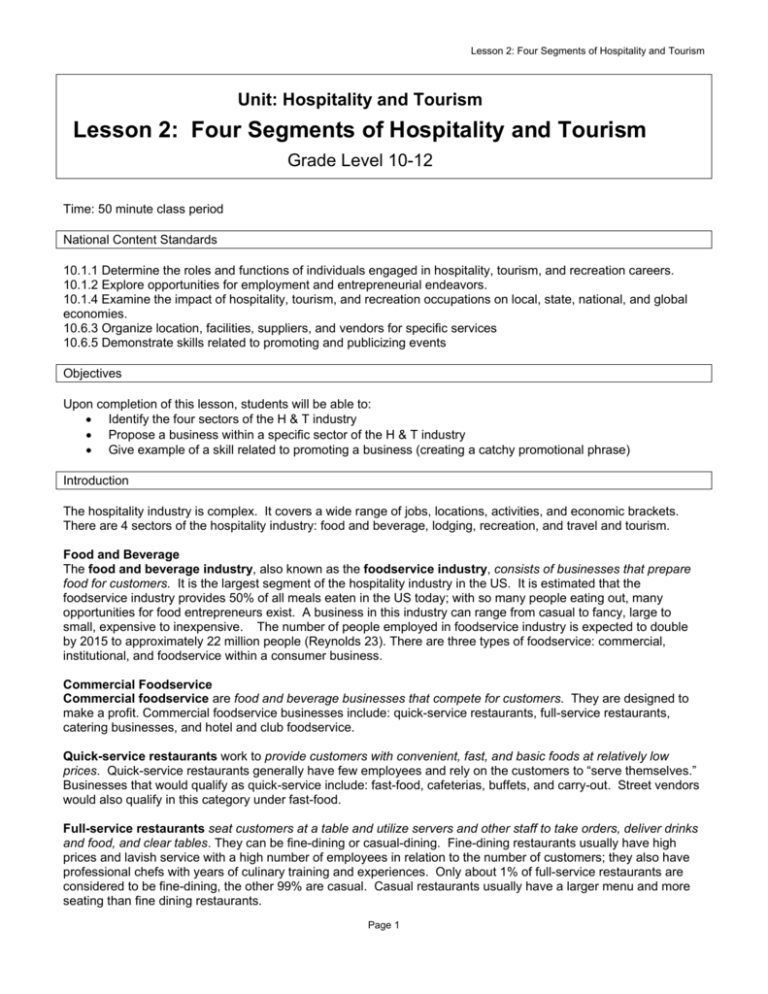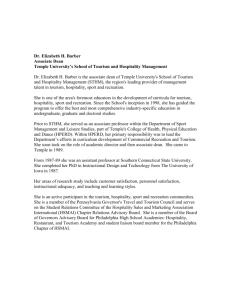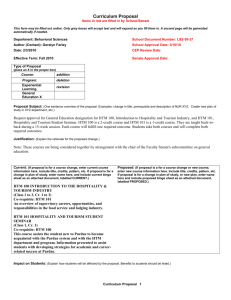Lesson 2: Four Segments of Hospitality and Tourism
advertisement

Lesson 2: Four Segments of Hospitality and Tourism Unit: Hospitality and Tourism Lesson 2: Four Segments of Hospitality and Tourism Grade Level 10-12 Time: 50 minute class period National Content Standards 10.1.1 Determine the roles and functions of individuals engaged in hospitality, tourism, and recreation careers. 10.1.2 Explore opportunities for employment and entrepreneurial endeavors. 10.1.4 Examine the impact of hospitality, tourism, and recreation occupations on local, state, national, and global economies. 10.6.3 Organize location, facilities, suppliers, and vendors for specific services 10.6.5 Demonstrate skills related to promoting and publicizing events Objectives Upon completion of this lesson, students will be able to: • Identify the four sectors of the H & T industry • Propose a business within a specific sector of the H & T industry • Give example of a skill related to promoting a business (creating a catchy promotional phrase) Introduction The hospitality industry is complex. It covers a wide range of jobs, locations, activities, and economic brackets. There are 4 sectors of the hospitality industry: food and beverage, lodging, recreation, and travel and tourism. Food and Beverage The food and beverage industry, also known as the foodservice industry, consists of businesses that prepare food for customers. It is the largest segment of the hospitality industry in the US. It is estimated that the foodservice industry provides 50% of all meals eaten in the US today; with so many people eating out, many opportunities for food entrepreneurs exist. A business in this industry can range from casual to fancy, large to small, expensive to inexpensive. The number of people employed in foodservice industry is expected to double by 2015 to approximately 22 million people (Reynolds 23). There are three types of foodservice: commercial, institutional, and foodservice within a consumer business. Commercial Foodservice Commercial foodservice are food and beverage businesses that compete for customers. They are designed to make a profit. Commercial foodservice businesses include: quick-service restaurants, full-service restaurants, catering businesses, and hotel and club foodservice. Quick-service restaurants work to provide customers with convenient, fast, and basic foods at relatively low prices. Quick-service restaurants generally have few employees and rely on the customers to “serve themselves.” Businesses that would qualify as quick-service include: fast-food, cafeterias, buffets, and carry-out. Street vendors would also qualify in this category under fast-food. Full-service restaurants seat customers at a table and utilize servers and other staff to take orders, deliver drinks and food, and clear tables. They can be fine-dining or casual-dining. Fine-dining restaurants usually have high prices and lavish service with a high number of employees in relation to the number of customers; they also have professional chefs with years of culinary training and experiences. Only about 1% of full-service restaurants are considered to be fine-dining, the other 99% are casual. Casual restaurants usually have a larger menu and more seating than fine dining restaurants. Page 1 Lesson 2: Four Segments of Hospitality and Tourism Catering businesses provide food and service for a special event. Catering usually involves feeding large numbers of people at one time, and the guests may be offered a variety of items to choose from or just a few. Special events that utilize catering can be for business or social occasions; these events may include: business meetings, receptions, awards dinners, holiday parties, weddings, proms, birthday parties, reunion, or charity events. Institutional Foodservice Institutional foodservice provides customers food and drink in an institution, such as a school, hospital, assisted living community, military base, prison, or factory. Institutional foodservice customers generally do not have the time or ability to seek food in a commercial foodservice business. Foodservice within a Consumer Business Foodservice within a consumer business is a food and beverage business that is located within a consumer business such as a movie theater, sports arena, museum, theme park, airport, or train station. It could be fullservice or quick-service. Customers generally do not seek these places out to dine in on any given day. Rather, they eat in these places because they are customers to the business they are within and choose to eat there out of convenience. Providing foodservice within a consumer business is another way for that consumer business to provide service to its customers. Lodging Lodging, also known as accommodation, is a place to sleep for one or more nights. A business in the lodging industry is a business that provides a place for people to sleep overnight. It can be one of many sleeping places such as a fancy hotel, a youth hostel, an elder hostel, a campground, or highway side motel. There are many different kinds of lodging that fit into four categories: full-service hotels, limited-service properties, specialty accommodations, and institutional housing. Both full-service hotels and limited-service properties offer rooms with private baths. Full-service hotels are more expensive than limited-service and are generally larger and fancier. Specialty accommodations may offer rooms with baths or may offer many rooms with a shared bath such as a bed-and-breakfast or one large bunk room/house with shared bathrooms such as a hostel. Institutional housing is housing found at colleges and universities, hospitals, prisons, and military bases. Lodging businesses can be in any number of locations depending on what population is being served. Resort lodging is near resorts, travel lodging near airports, and campgrounds near areas known for recreation. Lodging businesses market to many different market segments such as business travelers, convention and meeting attendees, leisure travelers, budget travelers, long-stay travelers, and special travelers such as those working with the airlines, government, and military. Below is a table of many different lodging options. Full Service hotels Convention Hotel Luxury Hotel Resort Hotel Hotel designed to provide for the needs of conventions and trade shows. Conventions are when large groups of people come together with a common interest. These hotels can house large numbers of people and have a large exhibit hall where convention meetings and exhibits can take place Hotel designed to provide the highest level of amenities, service, room furnishings, public spaces, and technology. These hotels are typically the most expensive hotels and tailor to the business and personal travel of people of higher economic status Hotel designed to cater to a vacationer or leisure traveler visiting a specific resort. Resorts are places where much of the economy is base on hospitality and Page 2 Lesson 2: Four Segments of Hospitality and Tourism ExtendedStay Hotel tourism. They generally have a climate, natural wonder, or activity that attracts a certain population. Examples include: Vail, Colorado for its skiing, Hawaii, for its beaches, and Moab, Utah for its biking, four-wheeling, and hiking terrain. Hotel is designed to house people for durations longer than 5 days. Most units have a kitchen, dining, and sleeping areas. Limited-service Hotels Limitedservice Hotels Budget Hotels Hotel is designed to offer medium level of service and midrange price. Many offer a continental breakfast, swimming pools, restaurants, and room service. Hotel designed for travelers on a tight budget. They have the lowest rates and least service. They have small rooms sand built in furniture. Specialty Accommodations Conference Centers Lodges Bed-andBreakfast Hostel Campgrounds Lodging facility business is generated by conference. These facilities offer places to sleep, eat, and meet in comfort. Lodging facility provides rooms and housekeeping for guests participating in a recreational activity. These range from 10- 100 rooms and are located in the proximity of the activity being done. Lodging facility provides rooms and breakfast to customers looking for a private home to stay in. These facilities usually offer between 1-5 rooms and are often found in charming places. They may be in the vicinity of great recreation or maybe are known for great food. They offer a more homey approach to lodging. Most are family owned and the guests interact with the host family throughout the day. Lodging facility provides inexpensive place to stay where sleeping, bath, and kitchen facilities are shared. No linens, toiletries, or housekeeping services are provided. They are very common throughout the world as places for young people can travel to and sleep cheaply for a few or many nights. The US Forest Service and US Park Service are the two largest operators of campgrounds in the US. However, KOA is a popular private campground business that operates throughout the US. They may have bathroom, water, and waste facilities, or they may not. They may charge per night or be free. Most often they are located in areas that are known for outdoor recreation and attractions. Institutional Housing Dormitory Senior Housing Lodging facility is a large building with many rooms that sleep 1-4 people and may have a sink but the rest of the bathroom facilities are shared with other residents. They are commonly found at colleges, universities, and private schools. Lodging facility provides housing, service, and food to people over age 55. They may be in apartment, dorm, or hotel style. They may also have medical care on site. Some senior housing is like a resort while others are more like hospitals with long term residents. Currently, senior housing is a rapidly growing market. Seniors often look for a place they can live independently without having to care for the building they are in, senior housing can provide that. Senior housing can also provide a safe place for seniors suffering from dementia and other illnesses when a family cannot take that senior into their own home. Recreation Recreation is any activity that people do for rest, relaxation, and enjoyment. The goal of recreation is to refresh a person’s body and mind. Any business that provides an activity for rest, relaxation, and enjoyment in order to Page 3 Lesson 2: Four Segments of Hospitality and Tourism refresh a person’s body and mind is in the recreation business. Recreation businesses are incredibly diverse because people have varying ideas on what activities they participate in for rest, relaxation and enjoyment. There are four general types of recreation businesses: entertainment, attractions, spectator sports, and participatory events. Entertainment businesses provide a show for you to watch such as a movie or live theater, and concerts. Attractions are places of special interest to visit such as natural scenery, museums, zoos, and historical sites. Spectator sports are sport that you watch others play such as foot ball games, baseball games, or the Olympics. Participatory sports or events are sports or events in which you take part in yourself such as sports, yoga retreats, or cooking schools. Travel and Tourism The travel industry is in the business of moving people from place to place. Busses, planes, cabs, boats, and passenger trains are all part of the travel industry. When people travel they spend money on hospitality. Pleasure or leisure travel is when a person takes a vacation and spends money on lodging, food, and recreation while on that trip. Business travel is when a person travels for work and also spends money on lodging and food. Some business travelers also spend money on recreation. The tourism industry provides those people with services that promote travel and vacations. Travel agencies, tour operators, cruise companies, convention planners, and visitors bureaus are all part of the tourism industry. The major function of the tourism is to encourage people to travel. When people travel they use hospitality services and when people spend money on hospitality, the businesses in that industry and the businesses that support that industry grow. Tourism helps many economies, on a local and national level, grow. As stated in the previous lesson, many jobs are provided directly by the hospitality industry. However, many jobs are indirectly provided by the hospitality industry as well. These jobs may include the lawyers whom work for hospitality businesses, the teachers whom teach the children in a resort community, and the construction, design, and landscaping employees whom create and maintain the buildings that the hospitality businesses are in. On a trip, most guests frequent business from all four segments of the hospitality industry. If a guest has a poor impression of anyone of those segments, that person may never visit that area or business again. This is why, all the segments of the hospitality industry must work together to successfully meet customer needs by providing excellent service. The following lesson will talk more about service. Body Anticipatory Set: 5 minutes Review Economic Impact of Hospitality and Tourism Homework • Have students break into groups of four to share the different ways money flowed into the economy based on their flow charts from Lesson 1, have each group turn in their homework. Body of Lesson 40 minutes • Keep students in groups of four and pass out the Four Segments of Hospitality & Tourism Industry information sheet. • Assign each group one section of the information sheet: food & beverage, lodging, recreation, and travel and tourism. If there are more than 16 students in the class, assign each topic to more than one group or break food and beverage down into three groups and travel and tourism into two groups. • Each will have 15 minutes to read their section and then create a mock business for their town that represents the sector of H & T for which they were responsible. Then each group will have 5 minutes to share information about their business type and their business specifically with the class. o Each group must have the following in their presentation to the class: Explanation of the H & T segment their business represents Explanation of the type of business they have created Name of the business Strategic location for their business • Can replace an existing business in town or be placed on an empty lot A catchy promotional phrase that would advertise the grand opening of the business Page 4 Lesson 2: Four Segments of Hospitality and Tourism • • Students may feel overwhelmed with this task, explain to them it is not going to be an end all finished product. Rather this exercise is to get them thinking about the different segments and the possibilities of entrepreneurship in their town. If they do not have all the required elements done by their time to present, have them present what they do have and individually finish the project for homework. Variation: Have students work independently on project with each reading the information sheet and creating a mock business in whichever sector they choose following the same guidelines as the group project. They can turn it the project in to be graded in outline form. Conclusion Review the 4 segments of the H & T industry and answer any questions. After the projects are collected, put some of the mock business ideas up on the bulletin board along with the pictures (from magazine or clip art) representing the 4 segments of the H & T industry. Materials Economic Impact of Hospitality and Tourism Homework from previous Lesson 1 assignment Four Segments of Hospitality & Tourism Industry information sheet. Businesses in the Four Segments of the Hospitality and Tourism Industry homework assignment Page 5 Lesson 2: Four Segments of Hospitality and Tourism Name Date Class Businesses in the Four Segments of the Hospitality and Tourism Industry Directions: • Read the section from Four Segments of Hospitality & Tourism Industry information sheet assigned to you. • Create a mock business in that sector for your town • Give a 5 minute presentation to the class including the following things: Explain to the rest of the class about the H & T segment you learned about Explain the type of business you have created Share the name of the business Share the strategic location of the business • Can replace an existing business in town or be placed on an empty lot Share a catchy promotional phrase that would advertise the grand opening of the business Use this space to brainstorm, take notes, or finalize your business project: Page 6




